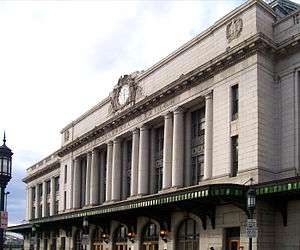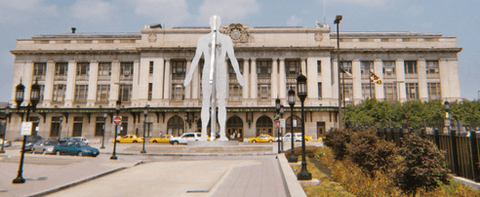Pennsylvania Station (Baltimore)
Baltimore, MD | ||||||||||||||||||||||||||||||||||||||||||||||||||||||||||||||||
|---|---|---|---|---|---|---|---|---|---|---|---|---|---|---|---|---|---|---|---|---|---|---|---|---|---|---|---|---|---|---|---|---|---|---|---|---|---|---|---|---|---|---|---|---|---|---|---|---|---|---|---|---|---|---|---|---|---|---|---|---|---|---|---|---|
|
Amtrak intercity rail station MARC commuter rail station Baltimore Light Rail station | ||||||||||||||||||||||||||||||||||||||||||||||||||||||||||||||||
 | ||||||||||||||||||||||||||||||||||||||||||||||||||||||||||||||||
| Location |
1515 North Charles Street Baltimore, Maryland United States | |||||||||||||||||||||||||||||||||||||||||||||||||||||||||||||||
| Coordinates | 39°18′27″N 76°36′56″W / 39.30750°N 76.61556°WCoordinates: 39°18′27″N 76°36′56″W / 39.30750°N 76.61556°W | |||||||||||||||||||||||||||||||||||||||||||||||||||||||||||||||
| Owned by | Amtrak | |||||||||||||||||||||||||||||||||||||||||||||||||||||||||||||||
| Line(s) | Northeast Corridor | |||||||||||||||||||||||||||||||||||||||||||||||||||||||||||||||
| Platforms |
3 island platforms (MARC and Amtrak) 1 side platform (Light Rail) | |||||||||||||||||||||||||||||||||||||||||||||||||||||||||||||||
| Tracks |
8 (MARC and Amtrak) 1 (Light Rail) | |||||||||||||||||||||||||||||||||||||||||||||||||||||||||||||||
| Connections |
| |||||||||||||||||||||||||||||||||||||||||||||||||||||||||||||||
| Construction | ||||||||||||||||||||||||||||||||||||||||||||||||||||||||||||||||
| Parking | 550 spaces[1] | |||||||||||||||||||||||||||||||||||||||||||||||||||||||||||||||
| Bicycle facilities | Bike Share Stop #21 (16 docks) | |||||||||||||||||||||||||||||||||||||||||||||||||||||||||||||||
| Disabled access | Yes | |||||||||||||||||||||||||||||||||||||||||||||||||||||||||||||||
| Other information | ||||||||||||||||||||||||||||||||||||||||||||||||||||||||||||||||
| Station code | BAL | |||||||||||||||||||||||||||||||||||||||||||||||||||||||||||||||
| History | ||||||||||||||||||||||||||||||||||||||||||||||||||||||||||||||||
| Opened | 1911 | |||||||||||||||||||||||||||||||||||||||||||||||||||||||||||||||
| Rebuilt | 1984 | |||||||||||||||||||||||||||||||||||||||||||||||||||||||||||||||
| Previous names | Baltimore Union Station | |||||||||||||||||||||||||||||||||||||||||||||||||||||||||||||||
| Traffic | ||||||||||||||||||||||||||||||||||||||||||||||||||||||||||||||||
| Passengers (2017) |
1,063,628 annually[2] | |||||||||||||||||||||||||||||||||||||||||||||||||||||||||||||||
| Services | ||||||||||||||||||||||||||||||||||||||||||||||||||||||||||||||||
| ||||||||||||||||||||||||||||||||||||||||||||||||||||||||||||||||
| ||||||||||||||||||||||||||||||||||||||||||||||||||||||||||||||||
|
Pennsylvania Station | ||||||||||||||||||||||||||||||||||||||||||||||||||||||||||||||||
| Location |
1525 N. Charles St., Baltimore, Maryland | |||||||||||||||||||||||||||||||||||||||||||||||||||||||||||||||
| Area | 1.9 acres (0.8 ha) | |||||||||||||||||||||||||||||||||||||||||||||||||||||||||||||||
| Built | 1911 | |||||||||||||||||||||||||||||||||||||||||||||||||||||||||||||||
| Architect | McKim, Meade, & White; Murchison, Kenneth W. | |||||||||||||||||||||||||||||||||||||||||||||||||||||||||||||||
| Architectural style | Beaux Arts | |||||||||||||||||||||||||||||||||||||||||||||||||||||||||||||||
| NRHP reference # | 75002097[3] | |||||||||||||||||||||||||||||||||||||||||||||||||||||||||||||||
| Added to NRHP | September 12, 1975 | |||||||||||||||||||||||||||||||||||||||||||||||||||||||||||||||
| Location | ||||||||||||||||||||||||||||||||||||||||||||||||||||||||||||||||
 Baltimore, MD Location within Baltimore | ||||||||||||||||||||||||||||||||||||||||||||||||||||||||||||||||
Baltimore Pennsylvania Station (generally referred to as Penn Station) is the main transportation hub in Baltimore, Maryland. Designed by New York architect Kenneth MacKenzie Murchison (1872–1938), it was constructed in 1911 in the Beaux-Arts style of architecture for the Pennsylvania Railroad. It is located at 1515 N. Charles Street, about a mile and a half north of downtown and the Inner Harbor, between the Mount Vernon neighborhood to the south, and Station North to the north. Originally called Union Station because it served the Pennsylvania Railroad and Western Maryland Railway, it was renamed to match other Pennsylvania Stations in 1928.[4]
The building sits on a raised "island" of sorts between two open trenches, one for the Jones Falls Expressway and the other the tracks of the Northeast Corridor (NEC). The NEC approaches from the south through the two-track, 7,660-foot Baltimore and Potomac Tunnel, which opened in 1873 and whose 30 mph limit, sharp curves, and steep grades make it one of the NEC's worst bottlenecks. The NEC's northern approach is the 1873 Union Tunnel, which has one single-track bore and one double-track bore.
Penn Station is the eighth-busiest rail station in the United States by number of passengers served each year.[2]
Services
Penn Station is served by Amtrak, MARC, and the Maryland Transit Administration's light rail system. The station is the northern terminus of the Light Rail's Penn-Camden shuttle, connecting the Mount Vernon neighborhood with downtown; the southern terminus is Baltimore's Camden Station. MARC offers service between Washington, D.C., and Perryville. Amtrak Acela Express and Northeast Regional trains from Penn Station serve destinations along the Northeast Corridor between Boston and Washington, D.C. Some Regional trains from the station continue into Virginia and serve Alexandria, Newport News, Norfolk, Roanoke, and points in between. Other long-distance trains from the station serve:
- St. Albans, Vermont
- Charlottesville, Virginia
- Raleigh and Charlotte, North Carolina
- Atlanta, Georgia
- New Orleans, Louisiana
- Jacksonville, Orlando, Tampa, and Miami, Florida
- Huntington, West Virginia
- Cincinnati, Ohio
- Indianapolis, Indiana
- Chicago, Illinois
In the 1970s and 1980s, Amtrak also offered service to Harrisburg and Pittsburgh, Pennsylvania, St. Louis, Missouri, and Atlantic City, New Jersey.
Before Amtrak's creation on May 1, 1971, Penn Station served as the main Baltimore station for its original owner, the Pennsylvania Railroad (PRR), though passenger trains of the Western Maryland Railway also used Penn Station as well. Until the late 1960s, the PRR also operated long-distance trains over its historic Northern Central Railway line from Penn Station to Harrisburg and beyond, such as "The General" to Chicago, the "Spirit of St. Louis" to its Missouri namesake, and the "Buffalo Day Express" and overnight "Northern Express" between Washington, DC, and Buffalo, New York. As late as 1956, this route also hosted the "Liberty Limited" to Chicago and the "Dominion Limited" to Toronto, Canada. The Baltimore Light Rail now operates over much of the Northern Central Railway's right of way in Baltimore and Baltimore County; however, the spur connecting Penn Station to this right of way is not the route originally taken by Northern Central trains. Baltimore Light Rail service began in 1997.
As part of the Northeast Corridor Improvement Project, the station was restored to its 1911 appearance in 1984.[5]
The station's use as a Western Maryland station stop allowed passengers from Penn Station to ride directly to various Maryland towns such as Westminster, Hagerstown, and Cumberland. Passenger service on the Western Maryland ended in 1958.
Baltimore Penn Station is also used for MARC train storage during the weekends and overnight via off-peak service times on tracks 1, 3, 5, and F.
- Amtrak Northeast Regional at station.

 Light RailLink train at station.
Light RailLink train at station. Charm City Circulator on Charles Street.
Charm City Circulator on Charles Street.
History
Pennsylvania Station opened on September 15, 1911. It is the third railroad depot on its North Charles Street site. The first one was a wooden structure built by the Northern Central Railway that began operating in 1873. This was replaced in 1886 by the Charles Street Union Station, which featured a three-story brick building situated below street level with a sloping driveway that led to its entrance and a train shed that measured 76 by 360 feet (23.16 by 109.73 meters).[6]
The old station was demolished in January 1910.
Checkers speech
During what became known as the Checkers speech, on September 23, 1952, Richard Nixon, then a U.S. Senator from California and the Republican Party's nominee for Vice President, cited Penn Station as the place where a package was waiting for him, containing a cocker spaniel dog his daughter Tricia would name "Checkers." Nixon referred to the station by its former name, "Union Station in Baltimore."
Male/Female sculpture controversy
In 2004, the City of Baltimore, through its public arts program, commissioned sculptor Jonathan Borofsky to create a sculpture as the centerpiece of a re-designed plaza in front of Penn Station. His work, a 51-foot (15.5 m)-tall aluminum statue entitled Male/Female, has generated considerable controversy ever since. Its defenders cite the contemporary imagery and artistic expression as complementing an urban landscape, while opponents criticize what they decry as a clash with Penn Station's Beaux-Arts architecture, detracting from its classic lines.

Station services
Penn Station offers a magazine store that sells quick necessities, and two restaurants, including Dunkin' Donuts, and Java Moon Cafe. Parking is available at the station through a garage with 550 parking spaces, owned by the Baltimore Parking Authority. ZipCar also has three vehicles based at the station.
Proposed hotel and remodel

Several proposals have been made to convert the upper floors of the station in a hotel. In 2001, an agreement was made with James M. Jost & Co. Inc. to convert the upper three floors into a 72-room hotel.[7] This project was never completed. The proposal resurfaced in 2006 with a new, unnamed developer.[8] This proposal was also never completed. In 2009, the idea surfaced once again as Amtrak announced it had reached an agreement with a developer for a 77-room hotel to be called The Inn at Penn Station.[9] This project was later reported as stalled along with many other hotel proposals in Baltimore.[10]
References
- ↑ "MARC Station Information".
- 1 2 "Amtrak Fact Sheet, FY2017, State of Maryland" (PDF). Amtrak Government Affairs. November 2017. Retrieved December 26, 2017.
- ↑ National Park Service (2010-07-09). "National Register Information System". National Register of Historic Places. National Park Service.
- ↑ Barbara Hoff (April 1975). "National Register of Historic Places Registration: Pennsylvania Station" (PDF). Maryland Historical Trust. Retrieved 2016-03-01.
- ↑ "Amtrak - Baltimore, MD (BAL)". TrainWeb. January 2011. Retrieved January 21, 2011.
- ↑ Rasmussen, Frederick N. (September 11, 2011). "Baltimore's Reconstructed Railroad Station Opened 100 Years Ago This Week". The Baltimore Sun. Retrieved September 11, 2011.
- ↑ Cohn, Meredith (9 August 2001). "Hotel Planned in Penn Station". The Baltimore Sun. Retrieved 28 August 2014.
- ↑ Mirabella, Lorraine (14 March 2006). "Amtrak revives its plan for hotel at Penn Station". The Baltimore Sun. Retrieved 28 August 2014.
- ↑ Gunts, Edward (May 29, 2009). "Amtrak: Baltimore Penn Station to Hotel". The Baltimore Sun. Retrieved May 29, 2009.
- ↑ "Hotel projects in Baltimore stalled or scrapped". The Baltimore Sun. Retrieved 28 August 2014.
External links
| Wikimedia Commons has media related to Baltimore Penn Station. |
- Amtrak – Stations – Baltimore Pennsylvania Station
- Pennsylvania Railroad Station, Baltimore City, including undated photo, at Maryland Historical Trust
- Baltimore Penn Station (TrainWeb)
- Station Building from Google Maps Street View
- Baltimore, MD (BAL) – Great American Stations
- Penn Station – Explore Baltimore Heritage
All of the following are filed under Baltimore, Independent City, MD:
- Historic American Buildings Survey (HABS) No. MD-1015, "Baltimore Union Station, Driveways, North of Jones Falls Expressway, between Charles Street & Saint Paul Street", 27 photos, 20 data pages, 3 photo caption pages
- Historic American Engineering Record (HAER) No. MD-50, "Union Junction Interlocking Tower, Bounded by Federal, Guilford, Royal, and Calvert Streets", 6 photos, 15 data pages, 1 photo caption page
- HAER No. MD-163, "Baltimore & Potomac Interlocking Tower, Adjacent to AMTRAK railroad tracks in block bounded by Howard Street, Jones Falls Expressway, Maryland Avenue & Falls Road", 11 photos, 27 data pages, 2 photo caption pages

